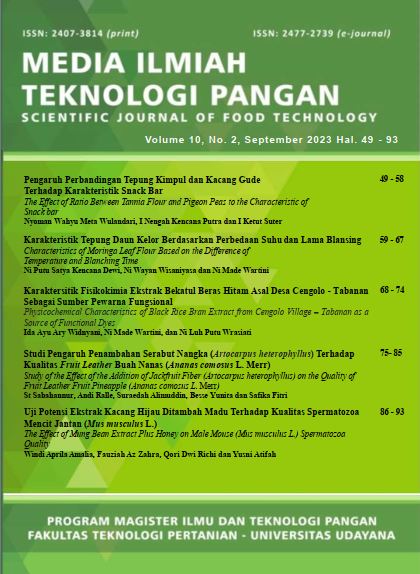PENGARUH PERBANDINGAN TEPUNG KIMPUL DAN KACANG GUDE TERHADAP KARAKTERISTIK SNACK BAR
Abstract
This research aimed to determine the effect between the tannia and pigeon pea flour ratio on the snack bar characteristics.This research was an experimental study using a Completely Randomized Design with tannia and pigeon pea flour ratio (70%:30%, 60%:40%, 50%:50%, 40%:60%, and 30%: 70%) as a treatment. Each treatment was repeated three times, so that obtained 15 experimental units. The variables observed were moisture content, ash content, protein content, fat content, carbohydrate content, crude fiber content, and sensory characteristics (color, flavor, taste, texture). The best treatment was determined using an effectiveness test. Furthermore, the best snack bar was observed for its dietary fiber, calcium, and antioxidant capacity. The results of the physical, chemical, and sensory characteristics test showed that the ratio of tannia and pigeon pea flour had a significant effect on the protein content, hardness level, and color of the snack bar but had no significant effect on the water content, ash, fat, carbohydrate, crude fiber, flavor, taste, and texture of the snack bar. The best treatment in this research was the ratio of tannia and pigeon pea flour of 30%:70%. This snack bar contains 5.31% water, 2.11% ash, 11.22% protein , 18.33% fat, 61.58% carbohydrate, 19.50% crude fiber, 65.41ppm calcium, 74.48 mg GAE/kg antioxidant capacity, 5.58% fiber, 136.52 N hardness level. The snack bar's sensory characteristics were: the color was liked; the flavor, taste, texture, and overall acceptance were liked moderately. The snack bar's color was brown, with a slightly distinctive tannia flavor, no itching taste, and a dense texture.








